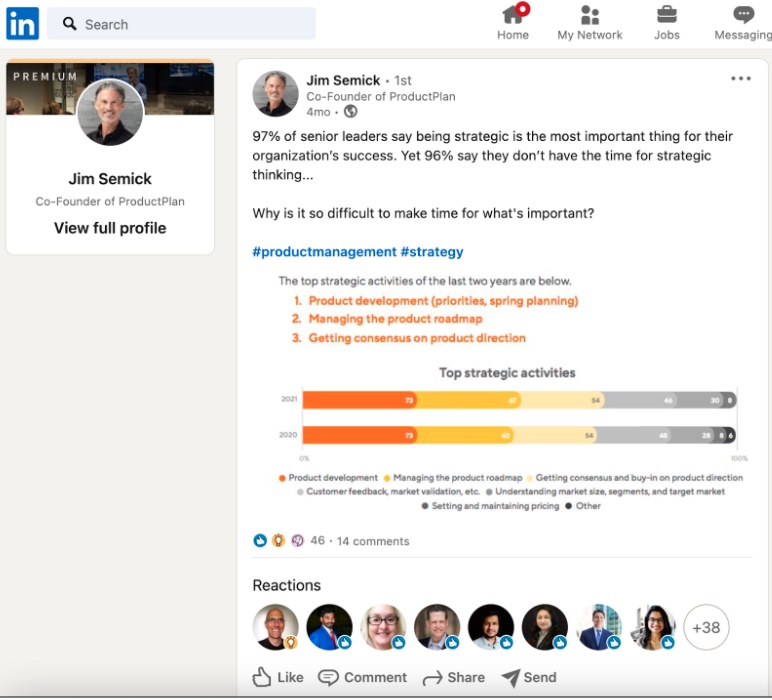In our 2021 State of Product Management report, 97% of senior leaders said being strategic is the most important thing for their organization’s success. But at the same time, 96% of those same leaders say they don’t have the time for strategic thinking and planning. So why is it so difficult to find time for strategic thinking and planning?
I threw this question to the crowd in a LinkedIn post and received some surprising and insightful responses.

Time Management
Time management remains an essential theme for product teams because there aren’t enough hours in the day. Strategic thinking and planning tend to fall to the sideline for other pressing needs.
One possible solution is “outsourcing” some strategic thinking to junior staff members before passing it onto senior management to make the final call.
“I think they don’t have the time to do so,” said associate product manager Evelyn EBO. “Hence the need to have young and innovative minds who follow the trends of the industry to come up with these strategic thoughts while the senior leaders review and align it with the organization’s business goals.”
Strategic thinking and planning may require some intentionality, but there are plenty of ways to work them into the rhythms and schedule of a product team, such as working on it as a team, carving out some “alone time” to focus on a deep dive, or holding an off-site session. It all starts with a commitment from leadership that strategic thinking and planning are worth the time and makes it a core tenet of the team’s approach.
Prioritizing Quick Wins
Nearly every product has a backlog of great ideas, and customers continually generate additional requests and wish lists. The backlog creates excessive pressure to deliver value and appease the “squeaky wheels” as quickly as possible.
That low-hanging fruit is so darn appealing because it’s an easy win. It offers minimal effort and rapid rewards. But just like junk food is initially filling and satisfying without providing a ton of nutritional value, constantly front-loading your development queue with these “quick wins.”
A feature-factory mindset means you’ll never get around to the complex, important work until it’s reached a crisis point. Moreover, the most critical projects may not cover every use case and contingency due to poor planning.
Turning an Abstract Concept Into Practice
Another common thread is the difficulty some product leaders and organizations have grappling with something as broad and malleable as “strategy.” Some teams have trouble defining the specific tactical actions required to work on a product strategy, and they sometimes struggle to define “strategy” in the first place.
“It can be difficult since ‘strategy’ is an abstract concept – at least for me,” said program manager Michael C’deBaca. “I’ve found it’s better first to define strategy. Here’s my take (not my idea, picked it up somewhere along the line): it’s identifying and quantifying business problems in the area of interest; deciding which problems to address; putting people, processes, and technology in place to execute the decisions; evaluating/measuring the execution; and finally acting on the evaluation/measurements. For me, this breaks down the abstract concept into smaller, and hopefully easier-to-work-on, pieces.”
Brant Cooper, an author, founder, and CEO, thinks a misunderstanding of strategic thinking even plagues many industries.
“I don’t think people even know what they mean by ‘strategic.’ It’s maybe worse management speak than ‘innovation,’” Cooper said. “Management consulting firms hire 20-something-year-olds to help with corporate strategy. I mean, really? I think they mean they wish they were more proactive. But they are reactive, go to too many meetings, fighting fires, pulling hair out, etc.”
Regardless of who does the upfront work, the product strategy must ultimately be aligned with stakeholders from across the organization and imbued in every product element, particularly the product roadmap. Strategy becomes the guiding principle for the team when you have company-wide support and align objectives.
Strategic Thinking and Planning Shouldn’t Require All of Your Time
Another take is that “being strategic” shouldn’t be a dedicated activity product leaders need to find time for… because they should already be doing it at all times!
With a top-down strategy in place, ensuring each tactical decision and minor task are all done with the overall strategy in mind is far more accessible. A solid strategic foundation prevents you from retrofitting existing structures and plans to a newly developed approach.
A sound strategy ensures a net positive outcome on your team’s goals, objectives, and overall vision. The vision remains the focus at all times, so it never requires any “extra effort.”
Stick to the Essentials of Strategic Thinking and Planning
Product managers and leaders never lack things to do. Our plates are always overflowing, and there’s inevitably another hat someone is desperate for us to wear. To break free of this neverending cycle, we must pare things back and do less overall, while ensuring what we are doing is truly important.
With an emphasis on strategic thinking and planning, we can focus our attention on what matters. To achieve this, we must learn how to say no. We must understand which product enhancements and features don’t support our strategy. Furthermore, we must also learn to say no to tactical activities that waste time.
Therefore, you must realize that you can’t do everything. Free yourselves and manifest the strategic thinker and planner customers want. Our products don’t need every bell and whistle. Moreover, it’s not practical to go to every meeting and read every customer support inquiry.
Using a strategic imperative as our guide, we can carve out the hours required to establish strategic thinking and planning. There will always be details to attend to, but you can’t let that get you distracted from your true objectives.
For more insights on how to become an essentialist product manager, download my free book here.


